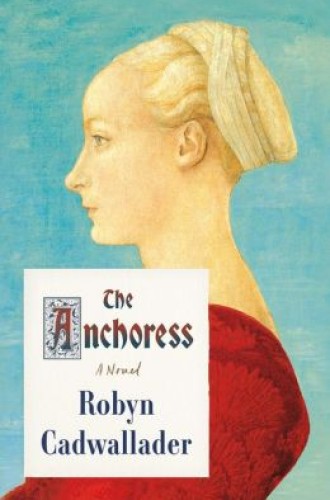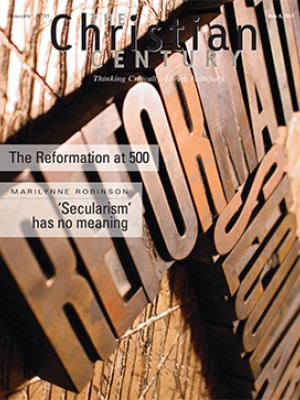A room to herself
The year: 1255. The place: the English Midlands. The protagonist: Sarah, the daughter of a silk merchant, 17 years old and lovely.
The local squire’s son, Sir Thomas, adores Sarah, but she spurns his advances. Sarah is in love with God and God alone; she longs to die to earthly desires by forever shutting herself away from human males. But Thomas refuses to leave Sarah alone, and even Father Ranaulf—a priest, a manuscript copyist, and Sarah’s spiritual adviser—finds the young woman strangely troubling.
Could there be a better setup for a medieval soap opera? It’s obvious what’s going to happen, right?
Wrong. Robyn Cadwallader knows far too much about the 13th century to write an anachronistic romance. In her doctoral thesis, “Three Methods for Reading the Thirteenth-Century Seinte Marherete: Archetypal, Semiotic, and Deconstructionist,” she discusses medieval attitudes toward female virginity and agency. The Anchoress, her first novel, is faithful to the 13th century not only in cultural and historical minutiae, but also in the characters’ attitudes. Sarah, Thomas, and Father Ranaulf behave like the medieval people they are—and that’s why the story may not be predictable to today’s readers.
Read our latest issue or browse back issues.
Sounds a bit pedantic. Boring, even.
Wrong again. There is no whiff of academia in Cadwallader’s style, which overlays straightforward narrative simplicity with a poet’s eye for detail. Here’s the setup: Sarah is still a teenager, but she knows about death. Her mother died years earlier while giving birth to Sarah’s brother. Her younger sister also died in childbirth, along with her unborn baby. Death is what happens to women who give in to the temptation of lust, Sarah believes.
But being a wife and mother is not her only option. Despite her father’s insistence that she marry well in order to rescue his foundering business, she has decided to become an anchoress: a woman who submits to a living death by being locked into a small, dim room attached to a church. Inside that room she will fast and pray and offer counsel to women who seek wisdom. She intends to stay in that room for the rest of her life.
Though Sarah’s room measures only seven by nine paces—at most, 18 by 22 feet—and its outside door has been nailed shut, she has three windows. One opens into a reception room where visitors can come to speak to her, one opens into her maids’ quarters, and a tiny one allows her to look into the adjoining church. When the maids leave their outside door ajar, she can overhear villagers talking to one another. Women come to see her, ostensibly for spiritual advice but sometimes just to chat. She learns of drunkenness, rape, unwanted pregnancy, and abuse. She knows that the priest who rails against sins of the flesh has a girlfriend and that the squire is cruel to the poverty-stricken villagers. And Sarah, unlike most of the villagers, can read. She spends long hours contemplating not only her rule, but also a book about the doughty fourth-century saint Margaret of Antioch. The world Sarah so longed to flee has invaded her enclosure.
So is this historical fiction, with Sarah narrating a story that takes place outside her cloistered walls?
Not quite. To be sure, the book includes many stories that go beyond Sarah’s immediate experience. Father Ranaulf, the most clearly drawn supporting character, even gets chapters of his own. And historical fiction buffs will appreciate the way the stories intersect with actual events and circumstances of the 13th century. Early in that century, for example, a rule—the Ancrene Wisse—was written especially for anchoresses. In 1235, the Statute of Merton allowed the lord of the manor to fence off large tracts of property, thus potentially denying farmers space to grow crops or graze sheep. Marriages arranged for financial reasons were common. Maternal and infant mortality rates were high. Few people could read. Many women chose vowed virginity over marriage.
On the other hand, much of the conflict in this novel takes place not in the village streets and farms but in Sarah’s head, and she is a highly conflicted young woman. Strapped to earth, she longs for heaven. Sensual by nature, she yearns to “let go of [her] woman’s body, its frailty and desire.” Striving to obey her rule, she turns away a starving leper and hardens her heart against a girl in serious trouble.
Self-discipline turns into self-mutilation. Anorexia follows, along with hallucinations. Sarah’s joints ache, her teeth loosen, she bruises easily. “I hadn’t thought suffering would be like this,” she muses, “so ordinary, so dull, and so endless.” In the chosen darkness of her cell, she begins to dream of gardens in the sun.
OK then, The Anchoress must be literary fiction!
Yes, if literary means that the story includes a lot of cogitation and involves no car chases and that the writing style is elegant and evocative. It can’t be easy writing a novel about 18 months in the life of a girl who never leaves her room. Yet Cadwallader, who has taught creative writing and published numerous poems and short stories, tells Sarah’s story in a way that is often sensual, occasionally suspenseful, and gripping from start to finish.
Less concisely, then, this book is an unusually accurate historical-romantic-literary novel with an underlying didactic current.
Despite her choice to focus on spiritual things in darkness and isolation, Sarah can’t keep the physical world at bay. Sunlight sneaks under the maids’ door. Neighbors bring well-seasoned food. Her senses awaken to previously ignored sounds and smells. A persistent cat adopts her, and a fearless bird builds a nest in the thatch of her roof. Even a hair shirt does not keep her from having a mystical—and frankly erotic—experience.
And then, just before her fierce asceticism is about to take her life, village women insist on nursing her back to health, and Sarah begins to notice what she’s been missing. “How had I walked about in the world for so many years,” she wonders, “and not been aware that its smell and its shape could knock my feet out from beneath me?” She knows she can’t continue seeking safety in darkness, but what will she do?
Though Cadwallader never preaches and only rarely lets her characters do so, her message is clear: holiness comes not from escaping the world but from taking the enormous risk of involving oneself in it, body and soul. “Blood and pain and bodies,” Sarah says to herself. “I looked at the crucifix above my altar as if for the first time, at the almond-shaped wound, the drops of blood. Where else was I so like Christ but in this body?”
If this attitude sounds more like contemporary America than medieval England, we may be underestimating our foremothers’ gutsiness. St. Margaret—the subject of Sarah’s favorite book as well as Cadwallader’s dissertation—is both a virgin and a dragon slayer. And in spite of rampant misogyny in their homes, village, and church, there are a lot of brave women in The Anchoress. By the end of the story, Sarah has become one of them.







